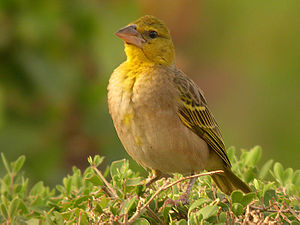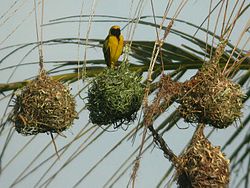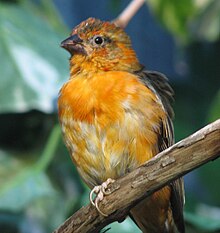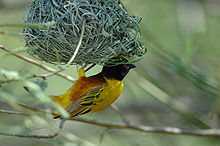Weaver birds
| Weaver birds | ||||||||||||
|---|---|---|---|---|---|---|---|---|---|---|---|---|

Village Weaver ( Ploceus cucullatus ) |
||||||||||||
| Systematics | ||||||||||||
|
||||||||||||
| Scientific name | ||||||||||||
| Ploceidae | ||||||||||||
| Sundevall , 1836 |
The weaver birds (Ploceidae), also Widah finches , are a species-rich family from the order of the passerine birds (Passeriformes). The family comprises 117 species in 15 genera. The conspicuous nest construction, which is characteristic of many species of weaver birds, gave it its name.
Occurrence
Most species inhabit forested areas, bush or open grasslands in Africa south of the Sahara . Few species live and breed in the tropical areas of Asia .
Way of life and characteristics
Many species of weaver birds are culture followers . That means they live close to people. The height is between 8 and 24 centimeters. The breeding dress of the male weaver birds usually has a yellow-black, gray-black, or black-and-white plumage. The females are usually colored more inconspicuously. When resting, the male resembles the female. They have a short, strong beak that is relatively thick at the root.
nutrition
The noisy and sociable weaver birds feed on insects , fruits , grains and seeds . They are often found in large groups and, like the bloodbeak weaver ( Quelea quelea ), can cause enormous damage in the grain fields. The swarms of bloodbeak weavers can include up to 100,000 individuals who roam a wide area in search of food. For East Africa it has been proven that individual swarms cover more than 1000 kilometers during their migration.
Nest building
Many species of weaver birds are colony breeders. The colonies can include thousands of birds. Often the hanging nests hang close together in the treetops of the trees.
construction
Among the weaver birds, it is predominantly the brightly colored, polygamous males who build the intricately woven, artful hanging nests with long, flexible and flexible plant fibers, feathers or wool. With the nests that are created before courtship, the males try to win over the more plainly colored females. In many species, multiple nests are built by a male to ensure that the female will adopt one of the nests. If a nest is accepted by a female, it takes care of the expansion of the interior. The nests have a spherical or bottle-shaped appearance, the entrance areas are either to the side or downwards. The shape of the nest and the technique of nest building vary from species to species. In certain species such as the short-winged weaver ( Ploceus nigricollis ) the nest has a long, downward-hanging entrance tube. The nest material is attached to the branches of trees, in bushes or to reeds with special knots and loops. The flexible plant fibers are wrapped around a branch. Then the collected blades of grass are linked. While the bird is holding the stalk, it devours the end of the stalk with its beak and over time creates a freely swinging shell that is gradually expanded into a nest.
In addition to the individual nests, community nests are also built. In the settler weavers ( Philetairus socius ) or also in the buffalo weavers ( Bubalornis niger ), the males build together on a large nest made of dry grass that is laid in trees or on telephone poles. It can reach a height of about three meters and a width of about 4.5 meters. The nest is divided into many demarcated areas and is inhabited by several hundred birds. The tube-like entry holes are located below the nest. A community nest is constantly being built. Therefore it can happen that trees collapse under the weight. It is particularly problematic with electricity or telephone poles. In order to counteract a collapse of the mast, the nests often have to be destroyed by humans.
Individual phases
Individual phases of nest building using the example of the village weaver ( Ploceus cucullatus ):
Predators
During the breeding season, the chicks are threatened by large birds such as the eagle and marabou , as well as by snakes , which are said to have more difficult access to the chicks due to the often narrow entrance holes below the nest and the location of the nest at the tips of the branches.
Genera and species
The classification of the weaver birds follows the current (2019) list of the International Ornithological Union , which indicates the following 117 species in 15 genera:
-
Amblyospiza (1 species)
- White- fronted weaver ( Amblyospiza albifrons )
-
Anaplectes (1 kind)
- Scarlet weaver ( Anaplectes rubriceps )
-
Brachycope (1 kind)
- Short-tailed weaver ( Brachycope anomala )
-
Bubalornis (2 species)
- Alektoweber ( Bubalornis albirostris )
- Buffalo weaver ( Bubalornis niger )
-
Dinemellia (1 kind)
- Star weaver ( Dinemellia dinemelli )
-
Fire weaver ( Euplectes ) (17 species)
- Tahaweber ( Euplectes afer )
- Spiegelwida ( Euplectes albonotatus )
- Schildwida ( Euplectes ardens )
- Gold-backed weaver ( Euplectes aureus )
- Stump wida ( Euplectes axillaris )
- Velvet wida ( Euplectes capensis )
- Diadem weaver ( Euplectes diadematus )
- Feuerwida ( Euplectes franciscanus )
- Bishop weaver ( Euplectes gierowii )
- Hartlaub's wida ( Euplectes hartlaubi )
- Flame Wida ( Euplectes hordeaceus )
- Lyra-tailed wida ( Euplectes jacksoni )
- Yellow-shouldered wida ( Euplectes macroura )
- Brandweaver ( Euplectes nigroventris )
- Oryx weaver ( Euplectes orix )
- Rooster tail wida ( Euplectes progne )
- Reichenowweber ( Euplectes psammocromius )
-
Foudia (7 types)
- Réunion weaver ( Foudia delloni ) - extinct
- Comoros weaver ( Foudia eminentissima )
- Rodrigue flavicans ( Foudia flavicans )
- Madagascar weaver ( Foudia madagascariensis )
- Rothschild weaver ( Foudia omissa )
- Mauritius weaver ( Foudia rubra )
- Seychelles weaver ( Foudia sixellarum )
-
Histurgops
- Red-tailed weaver ( Histurgops ruficauda )
-
Malimbus (10 species)
- Ballmann-Weber ( Malimbus ballmanni )
- Cassin-Weber ( Malimbus cassini )
- Crown weaver ( Malimbus coronatus )
- Red-bellied weaver ( Malimbus erythrogaster )
- Ibadan weaver ( Malimbus ibadanensis )
- Crested weaver ( Malimbus malimbicus )
- European red throat weaver ( Malimbus nitens )
- Rachelweber ( Malimbus racheliae )
- Climbing weaver ( Malimbus rubricollis )
- Tortoiseshell ( Malimbus scutatus )
-
Philetairus (1 species)
- Settlement weaver ( Philetairus socius )
-
Ploceus (67 species)
- Weeping Weaver ( Ploceus albinucha )
- Titmouse ( Ploceus alienus )
- Miomboweber ( Ploceus angolensis )
- Royal weaver ( Ploceus aurantius )
- Gold nape weaver ( Ploceus aureonucha )
- Shoulder patch weaver ( Ploceus badius )
- Baglafecht weaver ( Ploceus baglafecht )
- Highland weaver ( Ploceus bannermani )
- Brown-cheeked weaver ( Ploceus batesi )
- Bengal weaver ( Ploceus benghalensis )
- Bertrand Weber ( Ploceus bertrandi )
- Forest weaver ( Ploceus bicolor )
- Palm weaver ( Ploceus bojeri )
- Olive nape weaver ( Ploceus brachypterus )
- Kilomberoweber ( Ploceus burnieri )
- Cape weaver ( Ploceus capensis )
- Neck tape weaver ( Ploceus castaneiceps )
- Reed weaver ( Ploceus castanops )
- Village Weaver ( Ploceus cucullatus )
- Yellow bridge weaver ( Ploceus dichrocephalus, Ploceus dicrocephalus )
- Yellow-capped weaver ( Ploceus dorsomaculatus )
- Yellow-footed weaver ( Ploceus flavipes )
- Yellow weaver ( Ploceus galbula )
- Goland weaver ( Ploceus golandi )
- Giant Weber ( ploceus grandis )
- Heuglin weaver ( Ploceus heuglini )
- Hawfinch weaver ( Ploceus hypoxanthus )
- Brown cap weaver ( Ploceus insignis )
- Cabanis weaver ( Ploceus intermedius )
- Jackson weaver ( Ploceus jacksoni )
- Katanga weaver ( Ploceus katangae )
- Dwarf weaver ( Ploceus luteolus )
- Manyar weaver ( Ploceus manyar )
- Great-billed weaver ( Ploceus megarhynchus )
- Schwarzkopfweber ( Ploceus melanocephalus )
- Black-bellied weaver ( Ploceus melanogaster )
- Green weaver ( Ploceus nelicourvi )
- African weaver ( Ploceus nicolli )
- Carrot weaver ( Ploceus nigerrimus )
- Short-winged weaver ( Ploceus nigricollis )
- Black Chin Weaver ( Ploceus nigrimentus )
- Spectacle weaver ( Ploceus ocularis )
- Olive-headed weaver ( Ploceus olivaceiceps )
- Monk's Weaver ( Ploceus pelzelni )
- Baja weaver ( Ploceus philippinus )
- Preuss weaver ( Ploceus preussi )
- Prince weaver ( Ploceus princeps )
- Reichard-Weber ( Ploceus reichardi )
- Chestnut weaver ( Ploceus rubiginosus )
- Ruwet weaver ( Ploceus ruweti )
- Sakalave weaver ( Ploceus sakalava )
- St. Thomas Weber ( Ploceus sanctaethomae )
- Somali weaver ( Ploceus spekei )
- Fox weaver ( Ploceus spekeoides )
- Gold weaver ( Ploceus subaureus )
- Loangoweber ( Ploceus subpersonatus )
- Eyebrow weaver ( Ploceus superciliosus )
- Gold- mantled weaver ( Ploceus taeniopterus )
- Bocage weaver ( Ploceus temporalis )
- Three-colored weaver ( Ploceus tricolor )
- Masked Weaver ( Ploceus velatus )
- Yolk weaver ( Ploceus vitellinus )
- Weynsweber ( Ploceus weynsi )
- Saffron weaver ( Ploceus xanthops )
- Brown-throated weaver ( Ploceus xanthopterus )
-
Plocepasser
- Brown-cheeked Mahali ( P. superciliosus )
- Dornbuschmahali ( P. donaldsoni )
- Mahali weaver ( P. mahali )
- Red-backed Mahali ( P. rufoscapulatus )
-
Pseudonigrita
- Marble weaver ( P. arnaudi )
- Black- capped weaver ( P. cabanisi )
-
Quelea (3 species)
- Cardinal weaver ( Quelea cardinalis )
- Red-headed weaver ( Quelea erythrops )
- Bloodbeak weaver ( Quelea quelea )
- Sporopipes (2 species)
literature
- Joseph Forshaw (Ed.): Encyclopedia of Birds. 1999, ISBN 3-8289-1557-4 .
- C. Hilary Fry , Stuart Keith (Eds.): The Birds of Africa. Volume 7, Christopher Helm, London 2004, ISBN 0-7136-6531-9 .
Individual evidence
- ^ Frank Gill & David Donsker, IOC World Bird List v 8.2 : Old World sparrows, snowfinches, weavers
- ^ Anthony Cheke, Julian Hume: Lost Land of the Dodo. An Ecological History of Mauritius, Réunion & Rodrigues . Poyser, London 2008, ISBN 0-7136-6544-0 .
- ↑ Yellow-footed weaver ( Ploceus flavipes ) (Chapin, 1916) at Avibase





















